Primeurs 2011 Bordelais
EARLY APRIL IN BORDEAUX:
THE PRIMEURS WEEK
The 2010 with crus classés, discoveries, favourites and the new generation in the Châteaux
 And Château FAYAU - Château REIGNAC - Château FIGEAC - Château FRANC MAYNE - Château LE PIN - Château FAYAT
And Château FAYAU - Château REIGNAC - Château FIGEAC - Château FRANC MAYNE - Château LE PIN - Château FAYAT
Château HAUT BAILLY - Château LA LAGUNE - Château LABEGORCE - Château FONBADET On Monday April 4th taste buds were on the alert. Computer keys started to crackle, pens blackened white sheets to describe, dissect the vintage 2010. The big question was on everyone's lips: will the splendid 2009 be supplanted by the 2010? Was Bordeaux going to present again the vintage of the century?
As from the 2010 harvest, observing the climate of the summer and the analysis of the berries, a first answer was heard … “Probably very good”. The Merlot's blossom has been hampered by the quite fresh and wet weather of June causing flower abortion, millerandage and low yields. Despite all this, the 2010 vintage meets the five absolute prerequisites for a great—even very great—vintage:
- Early flowering and berry set,
- Progressive water stress creating a slowing down then a definitive stop of the growth of the vine during venison,
- A complete maturing of the varietals during hot and dry enough August and September without excessive heat,
- And at last, serene harvest without climatic hazards which enabled not to fear dilution or rot.
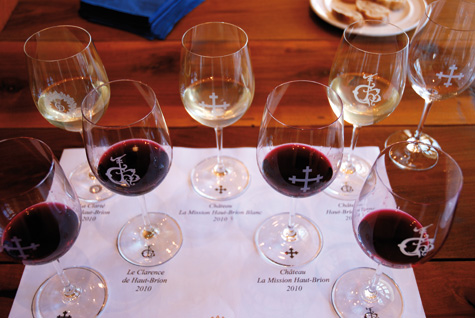
Certainly the water restraint the vine suffered from was harder and more general in the vineyard in 2010 than in 2009. “After a 2008 we underestimated, a more exuberant 2009 full of friendliness, the 2010 presents a more important structure, one of the driest vintages since 1949!” Jean-Pierre Moueix (Company Moueix in Libourne) explains. That makes some say that the 2010 resembles a 2005 by a more classic side, especially for the red wines. The Cabernet Sauvignon and the Cabernet Franc did very well. An obvious advantage: less pips in the berries, ripe, limiting the risk of harshness and bitterness. No preference between left bank and right bank! Merlot in lower yields but of excellent quality, Cabernet Franc that some wine growers never thought they could pick and Cabernet Sauvignon that has had all the time to ripen in good conditions. Colours are deep, wines are complex, intense, dense, with tannic frameworks that make expect a very good ageing potential.
Moderate diurnal heat, fresh nights in August and September favourable to the synthesis of the aroma precursors of the Sauvignon and Sémillon grapes, a preserved acidity, have created the ideal conditions for very great white wines, particularly in Graves and Pessac-Léognan. The fruit is brilliant and pure; the palate is smooth and complex. Dry white wines with more freshness and balance than the 2009.
As for the sweet wines, the short showers of September 6, 7, 8 have been beneficial to the arrival of the Botrytis cinerea that generalized after the rainfalls of October 3, 4, 9 and 10.
Less concentrated than 2009, 2010 reveals to be more ethereal with exotic fruit and flower aromas. More complex and expressive wines than 2009, offering elegance and delicacy in the mouth, a liquor without excess backed by a beautiful freshness.
After three weeks of tastings from Château to Château, this vintage appeared to be
“too much”: alcohol level, higher acidity than in 2009, colours, and tannins. It demanded to be very concentrated during the tastings because of the potentials it presented. To be noted also, the balance and respect of the fruit without ever, allowing exception, finding red wines marked by the maturing in barrels.
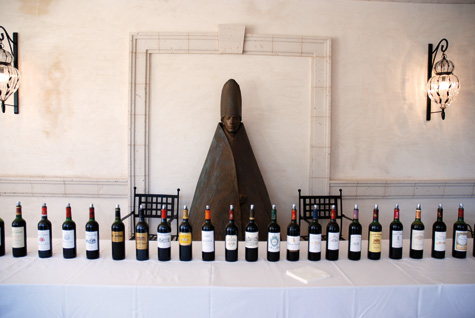
An analogy has swiftly been drawn between the 1989/1990 and 2009/2010 binomials. Yet global warming, the return to the vineyard and to the work of the soils, lower yields over the last years, more severe selections, vinifications at lower temperature led, in 2009 and 2010, to more precision in the definition of the wines made.
We notice great successes in the Médoc with excellent Cabernet Sauvignon used in bigger proportions in the blends, wonderful white Pessac-Leognan tenser than in 2009, more ethereal Sauternes et Barsac that are less opulent than in 2009.
On the right bank, mainly Merlot planted, the yields were 30 to 35% lower in volume compared to 2009. Many were those who asserted that they had never seen such a quality of the Cabernet Franc: despite a rather high alcohol level, freshness was there. More austere during the Primeurs tastings, possibly, but classicism was there with powerful and elegant tannic frameworks: a 2010 vintage for the lovers of Great Bordeaux wines, in compliance with a beautiful
“Bordeaux” image.
As for the famous issue concerning the release prices, a lot of people whisper that the price ranges will remain the same as in 2009. Some Châteaux announced them in view of Vinexpo that will open its doors from June 19th to 23rd in Bordeaux. The 2009 met such a success that the 2010 does not need to be too much “pushed” on the market.
For the 60 brands that move in the high spheres of luxury, the announcement will probably be done later, as they have to take into account: the global economic context, the Chinese's keen interest for certain wines, the special concern for the vintage during the Primeurs, the fragility of the Japanese market and the political context in Africa and the Middle East.
In this system, the purchase of a Primeur remains an act of faith in the future, the hope still to make a good deal at resale or the insurance of a flawless gustative capital.
Florence Varaine
BORDEAUX ET BORDEAUX SUPERIEUR CHÂTEAU FAYAU
FAR FROM THE PRIMEURS … BUT PRESENT ON BOTH BANKS
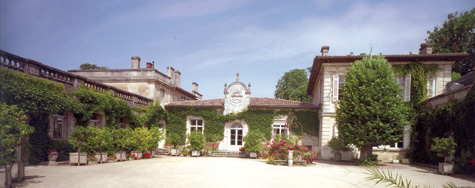
During the Primeurs week in Bordeaux, SommelierS International wanted to know about the whole of the aspects and implications of different actors. With this in mind, we met owners of the two banks and not classed in order to understand the quality of the vintage. We turned to the estates “Jean Médeville et fils” which head offices are located in Cadillac at the Château Fayau, and the production on a vast number of appellations. A viticultural property bought by cooper Jérôme Médeville in 1826 and which conquered from past to present through seven generations close to 200 hectares in all the colours of Bordeaux wines. The Vineyards “Jean Médeville et Fils” are present in 11 appellations out of the 60 of Bordeaux, as much on the left as on the right bank. For each vintage, innovations, investments are achieved like the Tribaie and soon the system Oenoview which enables to detect via satellite and GPS the more or less early production zones, in order to fit the harvest dates according to the knowledge of the terroirs and technicality. The use of modern technical tools, plot management, good reactivity, practical approach and tasting by the owners themselves, are still topical to make even better wines!
As for the 2010 Primeurs, here is an interview of Marc, Jean and Jacques Médeville:
“If we speak about rosés and clairets, these are technical wines. We are proud to have been awarded this year the Silver medal of the General Agricultural Contest of Paris for our Clairet “Sensations” 2010! For the other colours it as to be said that the climatic conditions saved the vintage. After the very pleasant summer, the few rain falls of September have been beneficial. Some picked before the rain, others afterwards … We preferred to harvest afterwards to ensure a more mature fruitiness for our white wines, lower the alcohol level and reach the classical 12.5/13°. For the red, it is a very homogeneous vintage; we have 8,000 hectoliters with a nice sibship of wines stemming from our estates. A good vintage in Bordeaux in red is to have fruit, colour and especially great freshness like in 2006, but with the flesh of the 2005. Since we follow up the property, 2010 is the best we ever made: fruity, intense, deep, fresh, without austerity, elegant. As for the dry white, this is a classical vintage. Whether in the appellation Bordeaux or in the Graves, we are very satisfied by the vintage.
Regarding our Sauternes or Cadillac sweet wines, the elders used to say that in a decade, three vintages were outstanding and that only one would go through time, without ever saying in advance or with certainty which one and why. 2010 will probably be that one: botrytised and desiccated grapes guarantee a lot of freshness and a lovely aromatic complexity. 2001 and 2007 were two exceptional years, just like our Cadillac sweet wine Château Fayau 2007 which was granted a medal at the contest of Paris in 2008. Now we have our third splendid vintage of the decade!
2010 is a classical vintage for the whole of the Bordeaux wines with more complexity, depth, homogeneous in quality, as much on the left than on the right bank, despite lower yields than expected. This Primeurs week remains virtual for us and our appellations. Certainly the Primeurs set the tone on speculative wines compared to ours, but indirectly they are going to guide the consumers and connoisseurs to choose us or not, compared to other appellations.”
Florence Varaine
www.medeville.com
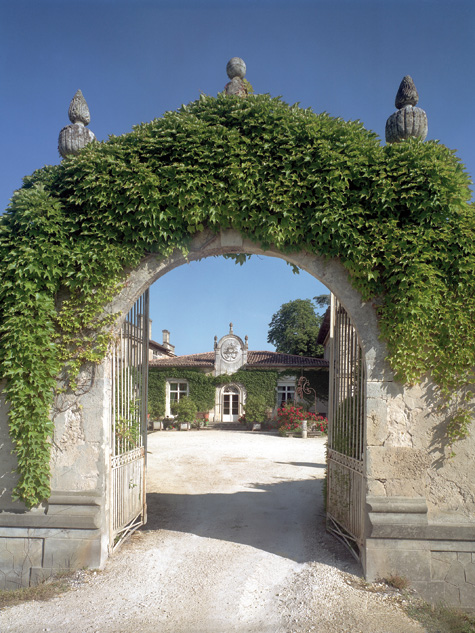 BORDEAUX ET BORDEAUX SUPERIEUR
BORDEAUX ET BORDEAUX SUPERIEUR CHÂTEAU REIGNAC
GRAND VIN DE REIGNAC: IT HAS EVERYTHING OF A GREAT!
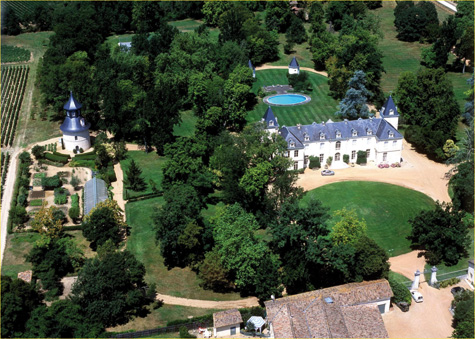
Less than 25 km north of Bordeaux, the Château de Reignac, whose history dates back to the 16th century, occupies one of the finest clay gravel ridges in the upper part of Saint-Loubès. It has a vast estate of 135 hectares, only 80 of which are planted, mostly with Merlot, followed by Cabernet Sauvignon and a little Cabernet Franc. Of the white wines, which account for 2 hectares, Sauvignon has the lion's share (60%), which is added to
Sémillon during blending.
At the highest point of the vineyard, the deep gravel soils are composed of pebbles and gravel dating from the Quaternary period. On the slope, 'molasse du Fronsadais' offers certain clayey features, and more to the south, marl and hard Castillon limestone are present.
Since 1990, Yves and Stéphanie Vatelot, the new owners, have been continuously renovating buildings, experimenting and measuring the tremendous potential of the terroir. In 1993, Yves Vatelot, a creative boat enthusiast, had a lake constructed on the estate, for his own pleasure of course, but also to provide protection against frost.
1996 marked the creation of Grand Vin de Reignac and of its recognition by R. Parker and the Grand Jury Européen! Vintages followed one another and the vineyard's reputation for quality was established. In 2002, a new milestone was reached with the purchase of 3 hectares on clay-limestone soil and the creation of the Cuvée Balthus, barrel-fermented using a method patented by Yves Vatelot, which he then extended to some of the wines of Reignac.
For both the white and red wines, the grapes are harvested by hand. The red wines are still made traditionally. Malolactic fermentation takes place in new barrels rotated to mix the lees, which naturally lends smoothness to the wine. For the Cuvée Balthus, totally fermented in new barrels, the trade secret allows it to be barrelled straight from harvest - for 35 days in 2010. This allowed for extraction of the soft tannins by simple rotation, running off and collection of the grape pomace for the wine press before the ageing process. The superb 2010 has a complex aromatic palate, smoothness, body and a beautiful structure in the mouth.
The white wines of Reignac, meanwhile, are produced using the Burgundy method. Recognised by skilled tasters and connoisseurs, the Grand Vin de Reignac accounts for 50 hectares of production. In 2007 it was joined by a second wine, simply called Château de Reignac, and by the Cuvée Balthus, a 100% Merlot with an average of 15 hectolitres per hectare. Thanks to meticulous work, a versatile and motivated team and an owner who is creative to the core, Reignac was ranked 5th best wine in the world for its price and quality, behind illustrious Cru Classé wines, at a blind tasting by the Grand Jury in 2001. Not long after, the Château and its owner featured in manga no. 21 of the series ‘Les Gouttes de Dieu’ (The Drops of God)!
Events continue at Reignac with a superb 2010, a project to plant an additional 2 hectares and a bamboo plantation to improve the treatment of wine-production effluent.
Florence Varaine
wwww.reignac.com
 RIVE DROITE - SAINT-ÉMILION
RIVE DROITE - SAINT-ÉMILION
CHÂTEAU AUSONE
PREMIER GRAND CRU CLASSÉ
From luxury to the reality of the crus
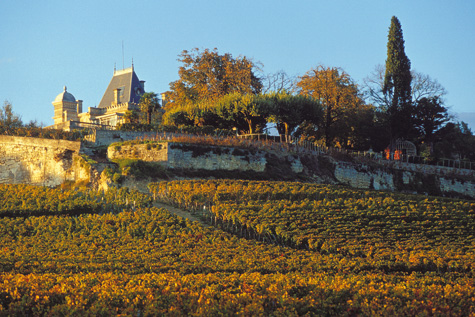
Each of us has always dreamt to enter Château Ausone's universe, to discover its underground cellars and the secret of a A of Saint-Emilion, on one of the exceptional terroirs of the appellation. Since 1973, Alain Vauthier runs the Ausone world. From 1997, new momentum, new expansion of the vineyard. In 2002, the château opens up to life. In 2005 the number of builders surpasses the number of wine growers on the estate and numerous works are planned to create a setting dedicated to tasting, reception and should be finished for Christmas 2011 … Alain Vauthier who follows up the works and the marketing keeps an eye on it.
With the same quest for excellence, of natural, of respect for nature, his daughter Pauline rejoins him in 2005. After a food-processing degree at secondary school, followed by a viticultural and oenologic vocational training certificate, then an experience in South Africa, she takes over the management of the 30 hectares of all the family properties, from Ausone to Château Fonbel: from luxury to the reality of the crus, each domain is run by the same team and in the same spirit.
Since she is a little girl, Pauline Vauthier has a passion for horse riding, and now for jumping. As in her job … She goes up through the ranks, commits herself a lot, with pugnacity and a hint of obstinacy. This spirit of permanent challenge, in horse riding as in estate follow-up, motivates her.
“I started as farm-worker. I went through all the stages: learning to use a tractor, a pomp, racking … in short, a necessary know-how to run and explain the simplest things, which seems an obvious fact, a strength. My weak point: mechanics!” Pauline Vauthier announces, adding “Don't call me Mrs Director, I am only the Technical Manager of the properties. We have an organic approach in the vineyard as in the winery, even in the choice of materials. On the estate some areas are managed in biodynamics, even if this approach has not totally convinced me. We prepare teas, 500 and 501 preparations. For some tasks we respect the lunar calendar … but we are far from converting whole Ausone into biodynamics … give me some time. In this spirit we took back a draft horse this year for one hectare; this has an emotional aspect because Marius used to ride his Percheron on the 7 hectares of Ausone not so long ago and … I am a rider.”
About the Primeurs: 2010, 2009 each have their style at Ausone. “The 2010 reveals to be richer, more structured, more alcoholic (14.5°) with more acidity, in short, a bit more of everything but perfectly in balance. It will really be a wine to be laid down a long time. We have had the chance to have three beautiful vintages since 2008” she asserts.
With those three wonderful years, the Chinese sirens could sing at Ausone …
“Certainly China is a market where we should be. But concerning Ausone, we do not have a sufficient volume (18,000 bottles) to meet demand. For the other crus, we establish through the Bordeaux traders. We have always worked with Bordeaux' trade because, as my father says: each has his own job. We are wine growers; we need merchants to sell our wines. Should it be for China or other countries, we have to be watchful about the risks of imitation.
Since 2005 we implemented an extremely efficient traceability system on each bottle of Ausone, that changes every year and of which I am the only one to know the details. For the other wines, the system is more classic. That represents a certain cost but we have to be irreproachable from the vine to the bottle, in respect for our customers” Pauline Vauthier explains.
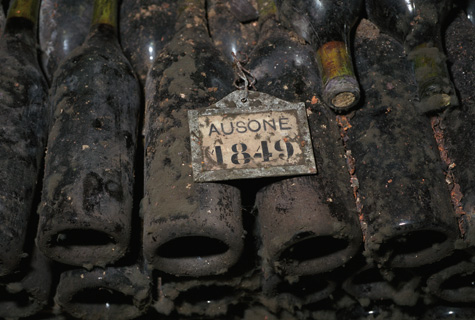
At last, to match the topical of the moment, let's come back to the classification …
“I think it is a pity it has come to that. From a certain point of view we lost all credibility since the suspension. The rules were clear and the same for everyone since 1955. We know that every ten years and during ten years we have to be at the top as we undergo assessment. For Ausone, we proved ourselves, ranking or not, things will not change. Its repute also enables us for example to better sell Moulin Saint-Georges, a Saint-Emilion Grand Cru: our work pays and is recognized. But it is detrimental for the image of Saint-Emilion.”
From a luxury universe to more classic properties in Saint-Emilion, Pauline, like her father, wants to preserve this family “Château” spirit which is also linked with the soul of Saint-Emilion and the historical structure of the vineyard.
www.chateau-ausone-saint-emilion.com
RIVE DROITE - SAINT-ÉMILION
CHÂTEAU ANGÉLUS
PREMIER GRAND CRU CLASSÉ
Tout Bordeaux en 2010 est un régal

Hubert de Boüard took over the reins of the property from his father in the 80s. He has never stopped since then to raise it up to an undeniable qualitative level. In the beginning some labeled him as “maker of Merlot jam marked by wood”. His style, his palate, and his knowledge of the terroir have refined the ins and outs. And despite criticism, some vintages of his early “career” still hold water, for the greatest pleasure of wine tasters. Creation of a style, regularity in the quality of his First wine, good understanding of the terroirs, enabled him to apprehend the wines produced on both banks of the Garonne. As a consultant, H. de Boüard follows the vintages of 32 properties, including family estates, through his company “Hubert de Boüard Consulting”. The latter is complemented by an oenology laboratory. “The structure is composed of my son Mathieu, of Philip Nunes, assistant oenologist and shareholder, and I. We plan the arrival of my daughter Stéphanie who currently lives in London. She will join us to develop the communication within the consulting activity and create events for all customers of the company,” he explains.
 As for the current events, Hubert de Boüard characterizes the 2010 as a great classic vintage, which differs from 2009 by the climatology and the wines' profile. “It is not better. Can we say a Matis is more beautiful than a Miro? ... This is very suggestive! There are two different styles: the 2009 is more baroque, exuberant and the 2010, very ecumenical, offers great purity, freshness and maturity. The latter gives superb white wines, with for example the Châteaux de Fieuzal or de Chantegrive. An excellent vintage, or even one of the finest vintages at Chantegrive (AOC Graves) in red. We harvested late and the difference is noticeable in the woodiness depending on the encasking, especially during the Primeurs week.” he confirms.
As for the current events, Hubert de Boüard characterizes the 2010 as a great classic vintage, which differs from 2009 by the climatology and the wines' profile. “It is not better. Can we say a Matis is more beautiful than a Miro? ... This is very suggestive! There are two different styles: the 2009 is more baroque, exuberant and the 2010, very ecumenical, offers great purity, freshness and maturity. The latter gives superb white wines, with for example the Châteaux de Fieuzal or de Chantegrive. An excellent vintage, or even one of the finest vintages at Chantegrive (AOC Graves) in red. We harvested late and the difference is noticeable in the woodiness depending on the encasking, especially during the Primeurs week.” he confirms.
A vintage with which consumers will be able, depending on their purchasing power, to indulge themselves—from 5 euros—in all appellations, or dream on great wines. With the 2010, Bordeaux remains the most attractive region of the world in terms of range, price and quality!
“Regarding Château Bellevue, bought three years ago, I feel pleasure in treading its full-of-potential terroir on which we began a big work of restructuration of the vineyard. The planted varietals are very old and have suffered. We manage to vinify a pure Merlot growing at 98% on limestone! Do not tell me Château Bellevue looks like Angélus: their wines are completely different! The Bellevue style is appreciated by the Saint-Emilion purists, the concept of terroir and varietals makes a big difference” Hubert De Boüard says, and he adds ... “The 2010 remains THE greatest vintage of Cabernet Franc since I started. Between yields and selection, we will have less First wine than 2009. I would have loved to make a 60% Cabernet Franc for my First wine of Angélus, but I must guarantee its soul and style. For the maturing of Angélus, we still use 100% of new barrels. Certainly, I have been criticized for my wines that are slightly marked by woodiness during the Primeurs, but putting the wine into barrels very early (end October) we have a well-integrated and elegant woodiness.”
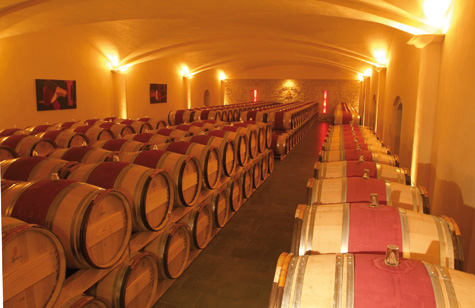
SommelierS International wanted to know Hubert De Boüard's position concerning the topical question of the Saint-Emilion classification:
“It should be quickly signed by the Ministry of Agriculture. There will be a classification, even if it has been organized and revised in urgency. The form being sometimes misunderstood, the INAO* and our committee have worked for a better understanding of the regulations, for them to be better comprehended by all wine growers and applicants. Today we have made a call for tenders in order to recruit an independent organization for the tastings and file control. I hope I will remain kind of serene and—let's be optimistic—see this new classification approved in autumn 2012.” It was necessary to revise the precepts of this classification, sometimes explain some points, sometimes add constraints (15 vintages in blind tasting for the Top Ranked Growths, a minimum of 50% of First Wine produced for each vintage), keeping an emulation spirit. Despite the hesitations of some, the rules will be identical for everyone and if, by protest, a property was to denounce the classification, only the file of the domain in question would be discussed again without cancelling or suspending the whole classification.
*National Institute for origin and quality
www.angelus.com
RIVE DROITE - SAINT-ÉMILION
CHÂTEAU FIGEAC
PREMIER GRAND CRU CLASSÉ
A long term vision
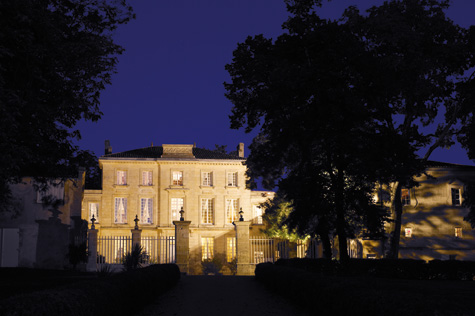
Located on the gravelly part of the far West of the plateau (60 hectares of the 5,565 of the AOC), one of the biggest estates of the city of Saint-Emilion with its 40 hectares of vines, Château Figeac is totally differently planted than the classic Saint-Emilion: 70% Cabernet (half Cabernet Franc, half Cabernet Sauvignon) and only 30% Merlot. Because of this
“atypicity” Figeac is sometimes called
“the most Médoc-style of Saint-Emilion”. In 2010, it was plunged into mourning with the death of Thierry Manoncourt, very distinguished man and fervent defender of the Saint-Emilion. His works and his vision are continued in the wines followed by his son-in-law Eric d’Aramon, with the necessary development of the consumption styles, with no concession to the trends though. Mister Manoncourt also was an extremely far-sighted man:
“In 1992, he modified the statutes of the company to include his four daughters among whom Laure, my wife, who is very present on the estate, to ensure that his possible succession can take place under optimum conditions” Eric d’Aramon explains.
The latter is in charge of Figeac for more than 20 years already and completely signs the vintages since 1998 with the team and the advices of Gilles Pauquet, consultant oenologist.
“My father-in-law and I defined a style for the wine. The soul of the wine of Figeac is above all made of a great distinction, fineness and a kind of drinkability, for pleasure. Our wines have to meet the expectations of our customers who love the classicism of a great dinner, white tablecloth and grand gastronomy, but also of those who like to drink a glass of Figeac as an aperitif. A vintage like 2001 for example is in this spirit! So we are working on more colourful wines, the quality of the tannins and the fruity expression. We are lucky we have wines that are drinkable even young having at the same time an extraordinary ageing capacity” he precises.
 Since 2010, Figeac initiated big works: the transformation of the former stables into a building hosting the offices, a meeting room and a tasting room. At the bottom of the Château, a farming building is being erected to install the equipment and vehicles of the property. To this is added a sewage collection system to have no more discharge of phytosanitary product at Figeac. A third phase is planned to renovate the winery changing the vats from 10 to 18 smaller ones, and to refine the plot selection, with the advantage at medium term to turn the wooden vat-room into a reception area.
Since 2010, Figeac initiated big works: the transformation of the former stables into a building hosting the offices, a meeting room and a tasting room. At the bottom of the Château, a farming building is being erected to install the equipment and vehicles of the property. To this is added a sewage collection system to have no more discharge of phytosanitary product at Figeac. A third phase is planned to renovate the winery changing the vats from 10 to 18 smaller ones, and to refine the plot selection, with the advantage at medium term to turn the wooden vat-room into a reception area.
“With regards to 2010, it would be lying to say that I am not satisfied by our vintage! Because of the flower abortion on the Merlot, the volume is lower. We are at 33 hectolitres/hectare instead of the usual 40. The 2009 is warmer, more flattering, and elegant. The 2010 is very different thanks to Cabernet Franc that are simply extraordinary and give more reserve, a fine and delicate tannic framework and ethereal aromas. This vintage is a great vintage for Figeac, very classic with a third of each varietal in the blend and a high alcohol level of 13.75° that does not mark the palate that is balanced by the freshness of the Cabernets.” 2010 news is rich in Figeac, but also in the appellation. SommelierS International wanted to know how the vintage was approached, and the vision of the
“future new” ranking:
“I am puzzled with this new regulation. It is still not validated by the Minister, physically; I do not see how we could publish the results for the 2012 harvest. Classed or not classed I will keep on working following the same principles. It is a pity that some have mistaken exam and competition since we implemented a numerus clausus in 1984. The former rules were good. It would simply have been a matter of developing it. I doubt on the committee that has been set up which is composed of tasters foreign to the Bordeaux area, and also on the fact to give 50% of the mark at the tasting and to take into account the repute of the wine that is fully subjective: we forget too swiftly the notion of 'appropriateness terroir/varietal'. In the spirit of an exam as the former regulation was at the root, only the malcontents should have been reassessed, without manhandling the whole of the owners who accepted the rules. It is topical to sue for anything. Let's take an example: my son does not pass his A-level because of a bad mark. Annoyed, I lodge a complaint. Do you seriously think I can cancel all the A-levels of France? Saint-Emilion needs a classification. It is a point of reference for the consumers and I support a classification and a competition for all the châteaux, and that would raise the level of all the wines. To me it might be dangerous to work in a hurry…” Eric d’Aramon comments.
To come back to more 'land/terroir' reflections and always go ahead, Eric d’Aramon and his wife have just bought a 21-hectare property in Grézillac in the Entre-Deux-Mers area, Château de Mouchac. While planning a total restructuring of the vineyard, they scheduled this year a first vintage in Bordeaux red. But
within the 3 coming years the 6 hectares planted with a white
varietal will enable to produce two colours. A new challenge!
www.chateau-figeac.com
RIVE DROITE - SAINT-ÉMILION
CHÂTEAU FRANC MAYNE
GRAND CRU CLASSÉ
Wine and charming hotel
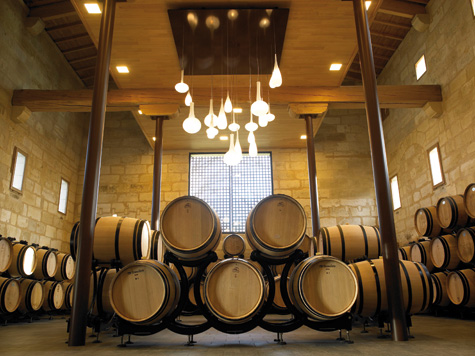
Before arriving at the city of Saint-Emilion by the high road, you cannot fail to miss, on the right, the entrance to the Château and the Relais Franc Mayne. Two entities, one a vineyard, and the other a boutique hotel. The single-block, 7-hectare vineyard surrounds the Château located on the Côte de Franc, to which it owes its name and its typical Saint Emillion terroir. Ninety percent Merlot and 10% Cabernet Franc sink their roots into a mostly clay-limestone soil, together with some molasse and sand at the bottom of the property. Beneath the upper part of the property are two hectares of underground galleries, old stone quarries, part of which has been converted into a barrel cellar.
Already the owners of Château de Lussac and Château Vieux Maillet, in 2005, Griet and Hervé Laviale took over the Château Franc Mayne, Cru Classé Saint-Émilion, and planned major significant changes starting in 2006: total renovation of the
batch-enabled vat room with wooden and stainless steel vats, allowing the use of gravity, together with a very contemporary first-year cellar. This investment proved very appropriate to expressing the characteristics and potential of the 2010 vintage.
Techniques included the use of gravity, cold maceration, punching down and pumping over, fermentation at 28°, then barrelling in 85% new barrels, which nevertheless did not mark the wines tasted en primeur. This gives a very fruity nose with an empyreumatic touch, certain sweetness in the mouth, polished tannins and a beautiful length. The only downside in 2010 for this Cru Classé Saint-Émilion was yields of only 25hl/ha!
The site, the underground quarries, the Gallo-Roman road taken by the pilgrims of Santiago de Compostella and the 16th century coaching inn prompted the owners to develop the property so that they could welcome wine enthusiasts from around the world in a premium wine tourism setting. With this goal, Château Franc Mayne, a typical 18th century Gironde house was totally renovated and personalised. The U-shaped building, constructed from limestone taken from the rock of Saint-Émilion,is now a boutique hotel with 12 themed rooms, a drawing room, a billiard room and a natural swimming pool for relaxing in the heart of the vineyard. It is possible to book the Château's dining room, for a small number of guests, to hold prestigious lunches or dinners accompanied by wines from the three properties. This summer, visitors will be able to try out the new and totally original walking tour of the quarries.
The result is a successful combination of architecture, design, sophistication and professionalism both for the hotel and the
vineyard.
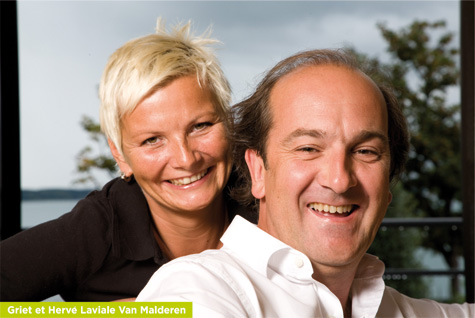 www.chateaufrancmayne.com
www.chateaufrancmayne.com
RIVE DROITE - SAINT-ÉMILION
Château Haut-Segottes
GRAND CRU
Discrete and sincerely Saint-Emilion

Danielle Meunier has received SommelierS International with a discrete smile, kindly, in her property, superbly located on the plateau of Saint-Emilion (the one of Figeac and Cheval Blanc): Château Haut-Segottes.
Since 1850, inheritances and marriages have enabled the domain to reach its current size of 9 hectares, across four sectors, the majority of which is around the castle. Danielle perpetuates the work of four generations, always paying attention to the constraints as well as to the potential of nature. In the Saint-Emilion Grand Cru appellation and in accordance with the terroir, the grape varieties include 60% of Merlot, 35% of Cabernet Franc—simply splendid in 2010—and 5% of Cabernet Sauvignon. Nature sometimes imposes on her to harvest only a rank or a plot. Never mind! The craft side of the job and the pursuit of the best expression of the terroir demand this. Note that 40 acres of Cabernet Franc date from 1932!
Helped by Cyrille Valadier in the vineyard and by David Hart in the winery, Danielle Meunier acts both like a wine grower and oenologist of a property that never disappoints. The wines produced in Saint-Emilion Grand Cru Haut-Segottes (30,000 bottles) and Clos Petit Corbin (18,000 bottles) in Saint-Emilion, have the undeniable race of the terroir, ideally set off by measured vinification and a maturing without bluster or default.
“Our wines are prepared from the pruning, taking into account the reaction of the vine in the past vintage. Then, we anticipate and adapt the pruning of the next vintage. Each vine stock is considered as such and we do not operate green harvest, she explains. I seek for anticipation of things and accept what nature gives me. For the harvest, manual of course, we use the services of an outside firm compared to the size of our vineyard and request an adjustment to plots of maturity. I am a music lover and I feel, during the stressful and exhilarating time of harvest and winemaking, like a conductor!” The delicate woodiness and the maturing of the wines of Haut-Segottes are achieved thanks to the barrels made by Vincent Darnajou, loyal to the property and craftsman cooper in his soul. Danielle Meunier likes to say that in the 80's, she has participated to competitions, tastings, and exhibitions. Gradually, the rumour has woven its web and the image of her cru settled: “A loyal clientele from private individuals, restaurateurs and cellarmen in France and abroad has been created. Direct and personalized relationships have been forged. I am every day on the estate; my wines are those who travel!”
The Saint-Emilion classification is on everyone's lips. Danielle Meunier certainly thought of asking her entry during the 90's for the promotion of her growth, her terroir and her know-how but now she says:
“I prefer to continue in the drawn way, with the good value for money of my wines, to not disappoint my very faithful customers: the first step of the classification would require to raise appreciably my prices ...”
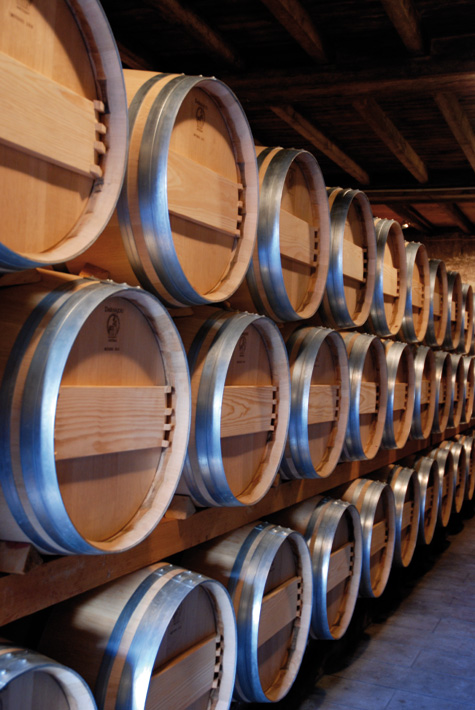
hautsegottes@wanadoo.fr
RIVE DROITE - POMEROL
VIEUX CHÂTEAU CERTAN
Working for the benefit of the vine and the wine
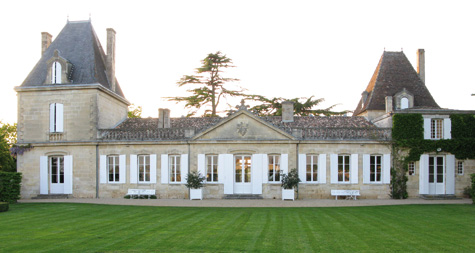
Surrounded by its neighbours, La Conseillante, L’Evangile and Pétrus, Vieux Château Certan is established as a sure thing. But being planted on the famous Pomerol plateau does not necessarily mean being ‘at the top’. Alexandre Thienpont is aware of this and likes to say that “man must work for the benefit of the terroir and the vines growing on it.”
The estate, inherited from his grandfather Georges Thienpont, appeared on the famous map of Pierre Belleyme as early as 1785, under the name of 'Sertan'. Currently, the estate's 14 hectares, in a single block, are laid out in 23 plots to refine the maturity and vinification of each batch. “Living in harmony with what nature has given me and understanding the cycle of the grape vine to bring each variety to its optimum is crucial to producing a Vieux Château Certan wine,” explains Alexandre Thienpont.
A keen observer, he plays on the desirability of the three terroirs available to him. For 2010, the Cabernet Franc was splendid, but only 8% of the best will be included in the Grand Vin. The estate has 30% Cabernet Franc, 65% Merlot and only 5% Cabernet Sauvignon. This low percentage measures up to Château Le Pin, which he co-owns and where he works the vines up to the maturity of the grapes. The grapes are harvested by hand and put into oak vats. The vinification of each variety is carried out in the most natural and traditional way possible in order to enhance and express the character of Vieux Château Certan. Without using exogenous products or yeasts, the wine is distinctive for its very careful vinification in keeping with the mark left by the wine-maker and nature. On tasting, words come easily - richness, subtlety, style, finesse but with a certain reserve. The wine only reveals itself over time with olfactory nuances and a particular energy in the mouth.
And when you finish the 2010 en primeur tasting speechless and you ask what vintage this brings to mind, Alexandre Thienpont says with a smile,
“the 2011!” Joking aside, we asked him to discern between the 2009 and 2010, the estate's duo:
“The 2010 is a scaled-down version of the 2009, with lower yields (35 hl/ha instead of 42), saved by the Cabernet Franc, with higher acidity and alcohol levels. This 2010, with a final blending (similar to 1998) of 86% Merlot, 8% Cabernet Franc and 6% Cabernet Sauvignon, is a very dark colour, totally extreme, but with remarkable balance and freshness!” he says.
“We must always take greater chances during the harvest and behind the scenes of technology in order to produce 2009 wines close to those of 1948 and 2010 wines close to those of 1950 - truly great vintages.”
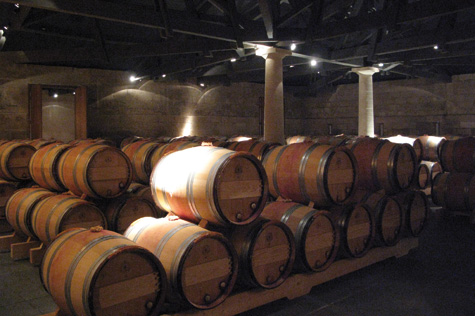
www.vieuxchateaucertan.com
RIVE DROITE - POMEROL
CHÂTEAU LE PIN
From the magic of a 'vin de jardin'
to the enchantment of fine quality
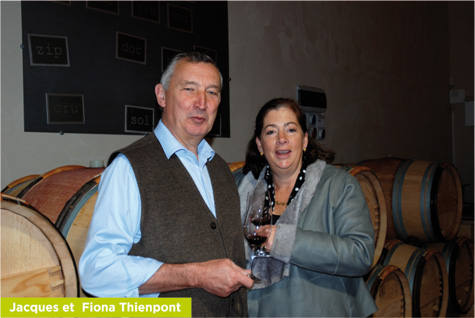
We cannot discuss the en premieur tasting of Château Le Pin without going into the history of the Thienpont family. This ‘vin de jardin’ existed well before the marketing term and the hype of 'vins de garage' in the 2000s - an attribute that is out of step with the charming, unassuming personality of Jacques Thienpont.
In 1842, the Flemish Thienpont family started taking an interest in the wine trade on the conviction of one woman, Camille Thienpont. Continuing along the family line, in the 20th century, Georges perpetuated the tradition and frequently visited Bordeaux. In 1921, he purchased Château Troplong Mondot in Saint-Emilion, then Vieux Château Certan in Pomerol. The Great Depression of 1929 forced him to sell Château Troplong Mondot. On his death, after having produced legendary wines at Vieux Certan, he bequeathed his wine production and trading business to his son, Leon. With the family custom preserved, the Thienponts are still in the trade and production of wine today: Luc Thienpont, on the left bank in Margaux; Jacques, merchant and owner of 2 hectares of Château Le Pin in Pomerol; Alexandre at Vieux Château Certan; Nicolas at Pavie Macquin and Larcisse Ducasse; and lastly François in the wine trade. This wine lineage is driven by the family ambition of raising every vintage to the heights of quality.
In 1979, on the advice of his uncle Léon, Jacques purchased 2 hectares on the famous plateau of Pomerol, next to Vieux Château Certan. This somewhat heterogeneous terroir - composed of topsoil containing old cobblestones and a complex underlying bed of ferruginous sandstone, gravel and sand - reveals wines with a Burgundy accent!
In this setting, the Merlot bears an exotic note that, in 1983, was acclaimed by Jacques Luxey as a 'Domaine de la Romanée Conti de Bordeaux'! A fine compliment to the couple, Jacques and his wife Fiona, Master of Wine, who live unassuming lives and like to keep their feet on the ground. Jacques, calm, thoughtful and passionate, makes the wines. Alexandre, co-owner, follows all the stages in the vineyard. For greater working convenience, Château le Pin has acquired a new and modern cellar - and brand new for Vinexpo 2011!
This limited production wine, with only 5,000 to 7,000 bottles, sits among the most prestigious wines of Pomerol. “We harvested just after a few short rains in September, which gave a more airy side to the wine. A long season, but with significant differences in night and day temperatures, gave a lot of creaminess and boldness to the wine, as in 1998. There is phenolic maturity and acidity, enhancing the vintage as the alcohol content is high at 14.2%! This is totally unheard of. But yields were lower by 20% in relation to 2009.” explains Jacques.
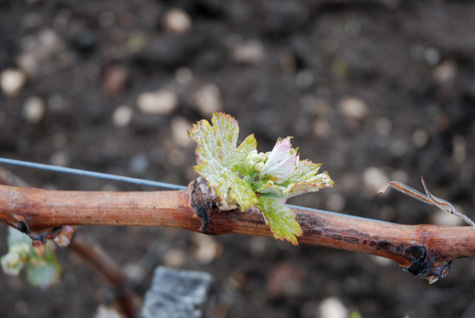
“Of course, we are pleased with our 2010, but let's let the tasters judge! Comparing vintages is like comparing children, and I don't like that. It is true that 2000 was a great vintage. For us, 2001 was superior, and we prefer 2006 to our 2005. The 2010 has a different style. We must retain a feel for the market. Admittedly, there is much financial liquidity and demand is growing. We sell 100% en primeur. The law of supply and demand is sending the retail price soaring. A kind of inflationary bubble! But if one only looks at the high price, my advice is to buy the Vieux Château Certan, more affordable but worked in the same way,” jokes Fiona.
Tél : 05 57 51 33 99
RIVE DROITE - POMEROL
ChÂteau la Conseillante
Happy Birthday!
During this en primeur period, there is cause for celebration in the Pomerol appellation with the 141st anniversary of the creation, the excellence and the dedicated passion to the terroir of Château La Conseillante. This vineyard, unchanged since its creation on the famous plateau of Pomerol, has been owned by the Nicolas family since 1871. The fifth generation of the Family Council, composed of Bertrand, Jean-Valmy and Henri Nicolas, currently manages the Château, marking the continuity and commitment of one family to a wine and its terroir. A neighbour of Pétrus and L'Évangile, and sitting opposite Cheval Blanc, its reputation is as established as the roots of its 11.8 hectares of vines.
During the en primeur period, Jean-Michel Laporte, Director since 2004 and responsible for the estate's operational management, welcomed each taster personally, inviting them to a Château La Conseillante vertical tasting, with, by natural way of introduction, the 2010 vintage, followed by the 2009, 2005, 2000 and 1990 and finishing in a blaze of glory with the 1945 - a trading bet. But my palate (editor's note) lingered with enthusiasm over the 1990 magnum - pure splendour!
For the 2010 vintage, we enjoyed an 80% Merlot and 20% Cabernet Franc with a yield similar to 2009 of about 39 hectolitres per hectare. It presents itself with power and freshness coupled with a certain distinction.
“We will produce 86% Grand Vin this year instead of our usual 95%. We still carry out malolactic fermentation in vats and controlled ageing in 85% new barrels. In 2009, we dedicated 100% new barrels to the wine of La Conseillante. Personally, the 2010 is close to the 2005 for its freshness, provided by the Cabernet, its concentration and its balance,” explains J.M. Laporte.
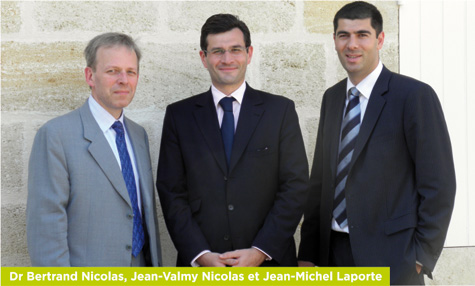
Pioneers of stainless steel in Pomerol with one of the oldest vat rooms (with that of Figeac) on the right bank, and eager to better express the character of its terroirs, Château La Conseillante is launching, this year, major works to adapt and modernise its vat room. This will include the subdivision of the 18 micro-plots and the acquisition of 22 vats. This facility is planned to come into operation for the harvest in 2012. It will allow for greater precision during batch fermentation and better selection during final blending. But this technical result would not have been possible without the preliminary work carried out by Jean-Michel Laporte: yield management, the search for optimum maturity, rigorous selection at the entrance to the vat room, a replanting policy, responsible wine-growing and, starting this year, a mating disruption programme in the vineyard* and the creation of a second wine, Duo de la Conseillante. In addition, replanting is










 As for the current events, Hubert de Boüard characterizes the 2010 as a great classic vintage, which differs from 2009 by the climatology and the wines' profile. “It is not better. Can we say a Matis is more beautiful than a Miro? ... This is very suggestive! There are two different styles: the 2009 is more baroque, exuberant and the 2010, very ecumenical, offers great purity, freshness and maturity. The latter gives superb white wines, with for example the Châteaux de Fieuzal or de Chantegrive. An excellent vintage, or even one of the finest vintages at Chantegrive (AOC Graves) in red. We harvested late and the difference is noticeable in the woodiness depending on the encasking, especially during the Primeurs week.” he confirms.
As for the current events, Hubert de Boüard characterizes the 2010 as a great classic vintage, which differs from 2009 by the climatology and the wines' profile. “It is not better. Can we say a Matis is more beautiful than a Miro? ... This is very suggestive! There are two different styles: the 2009 is more baroque, exuberant and the 2010, very ecumenical, offers great purity, freshness and maturity. The latter gives superb white wines, with for example the Châteaux de Fieuzal or de Chantegrive. An excellent vintage, or even one of the finest vintages at Chantegrive (AOC Graves) in red. We harvested late and the difference is noticeable in the woodiness depending on the encasking, especially during the Primeurs week.” he confirms.

 Since 2010, Figeac initiated big works: the transformation of the former stables into a building hosting the offices, a meeting room and a tasting room. At the bottom of the Château, a farming building is being erected to install the equipment and vehicles of the property. To this is added a sewage collection system to have no more discharge of phytosanitary product at Figeac. A third phase is planned to renovate the winery changing the vats from 10 to 18 smaller ones, and to refine the plot selection, with the advantage at medium term to turn the wooden vat-room into a reception area.
Since 2010, Figeac initiated big works: the transformation of the former stables into a building hosting the offices, a meeting room and a tasting room. At the bottom of the Château, a farming building is being erected to install the equipment and vehicles of the property. To this is added a sewage collection system to have no more discharge of phytosanitary product at Figeac. A third phase is planned to renovate the winery changing the vats from 10 to 18 smaller ones, and to refine the plot selection, with the advantage at medium term to turn the wooden vat-room into a reception area.






